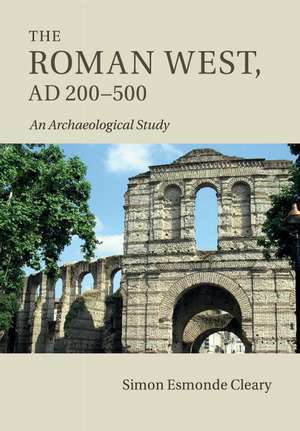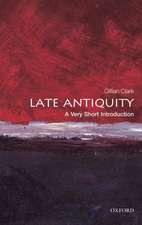The Roman West, AD 200–500: An Archaeological Study
Autor Simon Esmonde Clearyen Limba Engleză Paperback – 14 sep 2016
| Toate formatele și edițiile | Preț | Express |
|---|---|---|
| Paperback (1) | 368.08 lei 6-8 săpt. | |
| Cambridge University Press – 14 sep 2016 | 368.08 lei 6-8 săpt. | |
| Hardback (1) | 885.28 lei 6-8 săpt. | |
| Cambridge University Press – 6 mar 2013 | 885.28 lei 6-8 săpt. |
Preț: 368.08 lei
Nou
Puncte Express: 552
Preț estimativ în valută:
70.43€ • 73.54$ • 58.29£
70.43€ • 73.54$ • 58.29£
Carte tipărită la comandă
Livrare economică 05-19 aprilie
Preluare comenzi: 021 569.72.76
Specificații
ISBN-13: 9781316625644
ISBN-10: 1316625648
Pagini: 550
Ilustrații: 95 b/w illus.
Dimensiuni: 171 x 245 x 30 mm
Greutate: 0.87 kg
Editura: Cambridge University Press
Colecția Cambridge University Press
Locul publicării:Cambridge, United Kingdom
ISBN-10: 1316625648
Pagini: 550
Ilustrații: 95 b/w illus.
Dimensiuni: 171 x 245 x 30 mm
Greutate: 0.87 kg
Editura: Cambridge University Press
Colecția Cambridge University Press
Locul publicării:Cambridge, United Kingdom
Cuprins
Introduction; 1. Prologue: the 'third-century crisis'; 2. The military response: soldiers and civilians; 3. Christianity and the traditional religions; 4. Reshaping the cities; 5. Emperors and aristocrats in the late Roman West; 6. Rural settlement and economy in the late Roman West; 7. The economy of the late Roman West; 8. Breakdown and barbarians; 9. The fifth century and the disintegration of the Roman West; 10. Epilogue: AD 200–500, a coherent period?
Recenzii
'Esmonde Cleary begins by declaring his intention to 'emancipate archaeology from the role of servant'. In this, he can consider himself successful … [his] achievement is to put the two types of evidence on a level-footing, showing that they should be interrogated according to their own merits, rather than expected to fit into pre-determined, often incompatible, frameworks … As such, while this book will be greatly appreciated by experienced archaeologists, it is also a good guide for non-archaeologists who want to use the discipline to strengthen their work, but who might be hampered by the changing schools of thought or misled by the generalisations of earlier works.' Steven Spiegl, Bryn Mawr Classical Review
'… this is indispensible …' Choice
'… an extremely useful combination of a large quantity of the most current data and bibliography, and a generally balanced, nuanced and cautious history.' Douglas Underwood, The Classical Review
'This is a major work that is welcome not only in the field of late antique studies but in Roman archaeology as a whole. It presents a valuable synthesis of archaeological material from different areas in Western Europe, crossing boundaries of geography and scholarly tradition, but also offers important discussion and analysis. Its scale and emphasis on archaeology rather than history, though it is also dotted with sections of historical narrative, makes it an important addition to the field … undoubtedly a major resource … an important contribution and is very accessible and well presented.' Adam Rogers, Britannia
'… this is indispensible …' Choice
'… an extremely useful combination of a large quantity of the most current data and bibliography, and a generally balanced, nuanced and cautious history.' Douglas Underwood, The Classical Review
'This is a major work that is welcome not only in the field of late antique studies but in Roman archaeology as a whole. It presents a valuable synthesis of archaeological material from different areas in Western Europe, crossing boundaries of geography and scholarly tradition, but also offers important discussion and analysis. Its scale and emphasis on archaeology rather than history, though it is also dotted with sections of historical narrative, makes it an important addition to the field … undoubtedly a major resource … an important contribution and is very accessible and well presented.' Adam Rogers, Britannia
Descriere
This book focuses on the archaeological evidence, allowing fresh perspectives and new approaches to the fate of the Roman West.



















